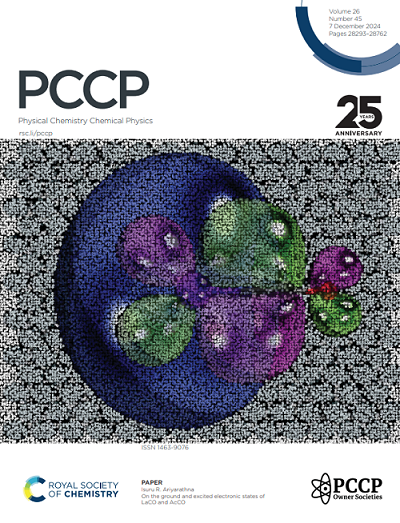Effect of Molecular Interaction on Strong Coupling Spectra in Molecules-nanocavity System
IF 2.9
3区 化学
Q3 CHEMISTRY, PHYSICAL
引用次数: 0
Abstract
The nanoparticle-on-mirror (NPoM) structure is an excellent platform for light-matter interaction studies. However, in the former theoretical studies of strong coupling, aggregates are typically treated either as a whole entity using the Drude model or by considering individual molecule-plasmon interactions while neglecting molecular interactions. In this study, we employ the continuum model to obtain the optical response of the NPoM, extracting the single-mode plasmon. Higher-order modes are approximated as modes within a metal-insulator-metal structure and treated as a background field. Using the master equation approach with a mean-field approximation, we investigate the effect of molecular interactions on strong coupling spectra. It is found that plasmon-mediated molecular interactions induce a red shift in the spectrum, whereas dipole-dipole interactions cause a blue shift. For each NPoM configuration, a threshold intermolecular distance can be defined where these two opposing interactions cancel out. Beyond this threshold, molecules can be treated as isolated emitters. Below this threshold distance, dipole-dipole interactions dominate, leading to a spectral blue shift. This work provides valuable insights for experimental studies of strong coupling in nanocavity-aggregate systems.分子相互作用对分子-纳米腔体系强耦合光谱的影响
镜面纳米粒子(NPoM)结构是研究光-物质相互作用的良好平台。然而,在以前的强耦合理论研究中,聚集体通常被视为一个整体,使用Drude模型或考虑单个分子-等离子体相互作用而忽略分子相互作用。在这项研究中,我们采用连续介质模型来获得NPoM的光学响应,提取单模等离子体。高阶模被近似为金属-绝缘体-金属结构中的模,并作为背景场处理。利用平均场近似的主方程方法,研究了分子相互作用对强耦合谱的影响。发现等离子体介导的分子相互作用引起光谱中的红移,而偶极子-偶极子相互作用引起蓝移。对于每个NPoM构型,可以定义一个阈值分子间距离,使这两个相反的相互作用相互抵消。超过这个阈值,分子可以被视为孤立的发射器。低于这个阈值距离,偶极-偶极相互作用占主导地位,导致光谱蓝移。这项工作为纳米空腔-聚集体系统强耦合的实验研究提供了有价值的见解。
本文章由计算机程序翻译,如有差异,请以英文原文为准。
求助全文
约1分钟内获得全文
求助全文
来源期刊

Physical Chemistry Chemical Physics
化学-物理:原子、分子和化学物理
CiteScore
5.50
自引率
9.10%
发文量
2675
审稿时长
2.0 months
期刊介绍:
Physical Chemistry Chemical Physics (PCCP) is an international journal co-owned by 19 physical chemistry and physics societies from around the world. This journal publishes original, cutting-edge research in physical chemistry, chemical physics and biophysical chemistry. To be suitable for publication in PCCP, articles must include significant innovation and/or insight into physical chemistry; this is the most important criterion that reviewers and Editors will judge against when evaluating submissions.
The journal has a broad scope and welcomes contributions spanning experiment, theory, computation and data science. Topical coverage includes spectroscopy, dynamics, kinetics, statistical mechanics, thermodynamics, electrochemistry, catalysis, surface science, quantum mechanics, quantum computing and machine learning. Interdisciplinary research areas such as polymers and soft matter, materials, nanoscience, energy, surfaces/interfaces, and biophysical chemistry are welcomed if they demonstrate significant innovation and/or insight into physical chemistry. Joined experimental/theoretical studies are particularly appreciated when complementary and based on up-to-date approaches.
 求助内容:
求助内容: 应助结果提醒方式:
应助结果提醒方式:


